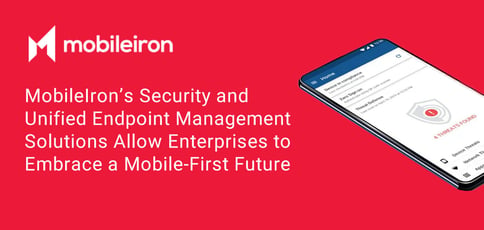
TL; DR: MobileIron’s zero-trust unified endpoint management (UEM) solution secures access and protects data across the enterprise. Since 2007, the organization has been empowering companies to leverage a mobile-centric approach that enhances productivity and the employee experience. Today, nearly 20,000 customers, including those from highly regulated industries, depend on MobileIron to secure mobile access to their business resources.
There couldn’t have been a better time to enter the market as a pioneer in mobile security than in 2007.
On June 29 of that year, Apple unleashed its groundbreaking first-generation iPhone, mesmerizing consumers of all generations. The same year, as the shiny new smartphones hit the pockets of countless business leaders, MobileIron launched with a mission to enable the secure use of mobile devices in the enterprise.
“After purchasing an iPhone for personal use, many executives began looking to bring the device into the office,” said Brian Foster, SVP Product Management at MobileIron. “IT teams had to quickly figure out how to secure access to data and track the device. With the right product at the right time, MobileIron became the first to act on helping them do so.”

MobileIron helps companies securely enable remote workforces.
Thirteen years later, amid a global pandemic, MobileIron is again stepping up to meet the mobile security and management needs of its customers — though this time in a far less ceremonious atmosphere.
“We ended up becoming part of the enterprise’s answer to the question of how to let people work from wherever they are in the world, which has been accelerated dramatically with COVID-19,” Brian said.
MobileIron is now empowering customers to sustain business innovation in this new perimeterless environment while ensuring devices, apps, and data are fiercely protected. The mobile-centric solution assumes that malicious actors are already in the network. Secure access is then granted using zero-trust unified endpoint management (UEM) technology.
Today, nearly 20,000 customers, including those from highly regulated industries, depend on MobileIron to provide employees with secure mobile access to business resources.
Taking a Mobile-Centric Approach Since 2007
Over the last 13 years, MobileIron has also seen the industry evolve through an increased focus on apps. The There’s An App for That phrase, highlighting the wide range of use cases for the mobile application, became so famous that Apple trademarked it in 2009.
“The whole phenomenon started as somewhat of a consumer trend, but it also happened in the enterprise,” Brian said. “One of our biggest customers has over 450 internal apps. So not only do you need to manage the security of the devices, but you also need to have a way to manage, secure, and deliver the applications that sit on those devices in the enterprise.”
Increasing cloud adoption has also transformed the way many businesses approach mobile security. Brian said that about six years ago, MobileIron released a version of its product hosted on public cloud in addition to its traditional on-premises format. As time has gone by, the company has seen approximately half of its customer base move to the cloud.
“I host product advisory boards with our top customers on a monthly basis, and one of the strategic conversations we’ve been having in the wake of COVID-19 is how to manage an increase in employees working from home,” he said. “The difference between customers who were hosting the platform on-premises versus those in the cloud was dramatic.”
While those running on-premise needed to install additional virtual machines to accommodate increased capacity, cloud customers didn’t have to take action. “We scaled up the cloud on our own to support increased usage,” Brian said.
Boost Productivity and Enhance the Employee Experience
Brian told us that businesses that put mobility at the center of the enterprise reap multiple benefits across various use cases and industries.
“Mobility could mean there’s a retail store that is using iPads so their workers are better able to track inventory and customer engagements,” he said. “There are also health care facilities where doctors carry around tablets to manage patient health records, and hospitals that are giving patients iPads so they can manage their own stay.”
Automotive manufacturers, on the other hand, may use armbands to hold small mobile devices that identify the location of car parts in a warehouse or provide instructions for their next task.

The company’s security and unified endpoint management solutions also improve customer experience.
“Enabling that mobility is the part that’s most exciting for me,” Brian said. “It’s the thread that unites everything that MobileIron does, and it’s becoming more important as time goes on.”
Brian told us that, in addition to streamlining operations and bolstering productivity, MobileIron can positively impact an employee’s perception of his or her job.
“Employee experience is becoming one of the most important metrics that enterprises must consider, and one of the ways MobileIron differentiates itself is by focusing on native user experiences on the mobile device,” he said. “Apple, Google, and Samsung spend a lot of time and money designing the interface for their phones — and we want to maximize those capabilities.”
Zero Sign-On: Tackling Password Pain Points
The MobileIron team is also focused on providing high-grade security while empowering users to be productive without passwords. The MobileIron security platform is built on a foundation of unified endpoint management (UEM) technology with a zero-trust, verification-based approach.
Zero sign-on (ZSO), which replaces passwords with mobile IDs, not only eliminates one of the biggest security gaps organizations face today but improves both productivity and the user experience. The solution provides passwordless access to resources like Office 365, Salesforce, G Suite, and Box while ensuring that unauthorized users, devices, apps, and services cannot connect to these applications.
MobileIron launched ZSO last year and continues to invest heavily in new capabilities centered on turning mobile devices into enterprise identity tools.
“Everybody has a phone with them,” Brian said. “We can secure that device and leverage the biometrics on that device to make sure it’s the right human. Once we’ve done those things, we can use your digital identity to seamlessly log into applications, devices — even doors, rooms, and buildings.”
Multi-factor authentication provides an additional layer of security when a user or device veers outside of compliance boundaries. It is hassle-free from a user’s perspective and prevents the misuse of an employee’s credentials in the case that they are stolen.
“Getting rid of passwords reduces friction and vulnerabilities to phishing,” Brian said. “Again, it’s about user experience, it’s about security.”
Aligning Customer Feedback and Product Innovation
Brian said MobileIron’s future can be broken down into three buckets — continued improvement of existing products, customer-fueled development, and pure innovation.
“As we release products, our product managers always continue to build them out and take them in new directions,” he said.
Of course, turning input into innovation also ensures MobileIron’s solutions evolve in a way that works for customers.
“With mobility, there’s a lot of commonalities but also opportunities for something a little different,” he said. “As we deploy products in these spaces, a lot of our road map is just responding to what customers ask for.”
HostingAdvice.com is a free online resource that offers valuable content and comparison services to users. To keep this resource 100% free, we receive compensation from many of the offers listed on the site. Along with key review factors, this compensation may impact how and where products appear across the site (including, for example, the order in which they appear). HostingAdvice.com does not include the entire universe of available offers. Editorial opinions expressed on the site are strictly our own and are not provided, endorsed, or approved by advertisers.
Our site is committed to publishing independent, accurate content guided by strict editorial guidelines. Before articles and reviews are published on our site, they undergo a thorough review process performed by a team of independent editors and subject-matter experts to ensure the content’s accuracy, timeliness, and impartiality. Our editorial team is separate and independent of our site’s advertisers, and the opinions they express on our site are their own. To read more about our team members and their editorial backgrounds, please visit our site’s About page.

